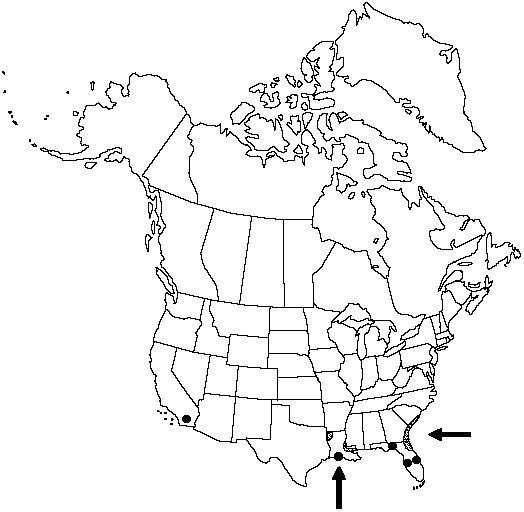Difference between revisions of "Cyrtomium falcatum"
Tent. Pterid. 86. 1836.
IntroducedIllustrated
Basionym: Polypodium falcatum Linnaeus f. Suppl. Pl., 446. 1782
Treatment appears in FNA Volume 2.
FNA>Volume Importer |
imported>Volume Importer |
||
| (7 intermediate revisions by 2 users not shown) | |||
| Line 7: | Line 7: | ||
|year=1836 | |year=1836 | ||
}} | }} | ||
| − | |basionyms={{Treatment/ID/ | + | |special_status={{Treatment/ID/Special_status |
| + | |code=I | ||
| + | |label=Introduced | ||
| + | }}{{Treatment/ID/Special_status | ||
| + | |code=F | ||
| + | |label=Illustrated | ||
| + | }} | ||
| + | |basionyms={{Treatment/ID/Basionym | ||
|name=Polypodium falcatum | |name=Polypodium falcatum | ||
|authority=Linnaeus f. | |authority=Linnaeus f. | ||
| + | |rank=species | ||
| + | |publication_title=Suppl. Pl., | ||
| + | |publication_place=446. 1782 | ||
}} | }} | ||
|synonyms= | |synonyms= | ||
| Line 19: | Line 29: | ||
}}<!-- | }}<!-- | ||
| − | --><span class="statement" id="st- | + | --><span class="statement" id="st-undefined" data-properties=""><b>Stem </b>scales orange-brown, ovate with attenuate apices. <b>Leaves</b> 30–60(–100) cm. <b>Pinnae</b> bright green and shiny adaxially, 4–10(–12) pairs, ovate-attenuate, usually falcate, 4–8.5 cm, leathery, sometimes with short, basal, acroscopic lobe, margins often undulate or coarsely and irregularly dentate. <b>Indusia</b> brown, sometimes with blackish centers, not shriveled at maturity. n = 2n = 123, apogamous.</span><!-- |
-->{{Treatment/Body | -->{{Treatment/Body | ||
| Line 25: | Line 35: | ||
|elevation=0–100 m | |elevation=0–100 m | ||
|distribution=Calif.;Fla.;Ga.;La.;Miss.;S.C.;Europe;Asia. | |distribution=Calif.;Fla.;Ga.;La.;Miss.;S.C.;Europe;Asia. | ||
| − | |discussion=<p>Cyrtomium falcatum is native to east Asia and widely escaped from cultivation. All plants in the flora appear to be the 32-spored, apogamous triploid.</p> | + | |introduced=true |
| + | |discussion=<p><i>Cyrtomium falcatum</i> is native to east Asia and widely escaped from cultivation. All plants in the flora appear to be the 32-spored, apogamous triploid.</p> | ||
|tables= | |tables= | ||
|references= | |references= | ||
| Line 34: | Line 45: | ||
-->{{#Taxon: | -->{{#Taxon: | ||
name=Cyrtomium falcatum | name=Cyrtomium falcatum | ||
| − | |||
|authority=(Linnaeus f.) C. Presl | |authority=(Linnaeus f.) C. Presl | ||
|rank=species | |rank=species | ||
| Line 44: | Line 54: | ||
|elevation=0–100 m | |elevation=0–100 m | ||
|distribution=Calif.;Fla.;Ga.;La.;Miss.;S.C.;Europe;Asia. | |distribution=Calif.;Fla.;Ga.;La.;Miss.;S.C.;Europe;Asia. | ||
| + | |introduced=true | ||
|reference=None | |reference=None | ||
|publication title=Tent. Pterid. | |publication title=Tent. Pterid. | ||
|publication year=1836 | |publication year=1836 | ||
| − | |special status= | + | |special status=Introduced;Illustrated |
| − | |source xml=https:// | + | |source xml=https://bitbucket.org/aafc-mbb/fna-data-curation/src/2e0870ddd59836b60bcf96646a41e87ea5a5943a/coarse_grained_fna_xml/V2/V2_82.xml |
|genus=Cyrtomium | |genus=Cyrtomium | ||
|species=Cyrtomium falcatum | |species=Cyrtomium falcatum | ||
| − | |||
| − | |||
| − | |||
| − | |||
| − | |||
| − | |||
| − | |||
| − | |||
| − | |||
| − | |||
| − | |||
| − | |||
| − | |||
| − | |||
| − | |||
| − | |||
| − | |||
| − | |||
| − | |||
| − | |||
| − | |||
}}<!-- | }}<!-- | ||
-->[[Category:Treatment]][[Category:Cyrtomium]] | -->[[Category:Treatment]][[Category:Cyrtomium]] | ||
Latest revision as of 20:25, 5 November 2020
Stem scales orange-brown, ovate with attenuate apices. Leaves 30–60(–100) cm. Pinnae bright green and shiny adaxially, 4–10(–12) pairs, ovate-attenuate, usually falcate, 4–8.5 cm, leathery, sometimes with short, basal, acroscopic lobe, margins often undulate or coarsely and irregularly dentate. Indusia brown, sometimes with blackish centers, not shriveled at maturity. n = 2n = 123, apogamous.
Habitat: Brick or stone walls, rocky areas, mesic forests, and coastal bluffs
Elevation: 0–100 m
Distribution

Introduced; Calif., Fla., Ga., La., Miss., S.C., Europe, Asia.
Discussion
Cyrtomium falcatum is native to east Asia and widely escaped from cultivation. All plants in the flora appear to be the 32-spored, apogamous triploid.
Selected References
None.
Lower Taxa
None.
